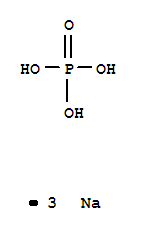Your Location:Home > Products > chemicals for Detergent > Trisodium Phosphate(TSP)



CasNo: 7601-54-9
MF: Na3PO4
Appearance: White crystalline powder
|
Preparation |
Trisodium phosphate may be prepared in two steps, first by adding a little excess of sodium carbonate to phosphoric acid and then boiling the solution to expel carbon dioxide. Sodium hydroxide is then added to the solution: Na2CO3+ H3PO4→Na2HPO4+ CO2+ H2O Na2HPO4+ NaOH →Na3PO4+ H2O Alternatively, trisodium phosphate may be prepared by complete neutralization of phosphoric acid with sodium hydroxide, followed by evaporation and crystallization: H3PO4+ 3NaOH →Na3PO4+ 3H2O |
|
Hazard |
Toxic by ingestion, irritant to tissue. |
|
Flammability and Explosibility |
Nonflammable |
|
Mechanism of action |
TSP is a tribasic orthophosphate with a pH of 10.0–12.0 in aqueous solution, and overall alkalinity aids in its interaction with cell membrane lipids, resulting in membrane leakage . TSP may also increase the sensitivity of some microorganisms to nisin and lysozyme. |
|
Safety Profile |
Moderately toxic by intravenous route. Mutation data reported. A strong, caustic material. When heated to decomposition it emits toxic fumes of Na2O and POx. See also PHOSPHATES. |
|
Laxative and Electrolyte Replacement |
Trisodium phosphate (TSP) is utilized as a laxative and for electrolyte replacement purposes due to its basic properties and ability to provide reusability in such applications. |
|
Catalytic Applications |
Trisodium phosphate finds application in catalysis, particularly in reactions such as glycerol carbonate synthesis, synthesis of 尾-hydroxyl ketone, and methanolysis. Its alkali property makes it suitable for catalyzing transesterification reactions in biodiesel production, yielding high biodiesel yields under mild reaction conditions. |
|
Inorganic Compound |
Trisodium phosphate is an inorganic compound characterized by its crystal structure containing three sodium atoms and a phosphate group. Apart from its medicinal uses, it catalyzes various chemical reactions. |
|
Crosslinker |
Trisodium phosphate (TSP) is selected as a crosslinker due to its single phosphate donation, which prevents excessive aggregation and yields stable and homogeneous systems. This property makes it suitable for various applications requiring crosslinking. |
|
Depressant in Mineral Processing |
In mineral processing, TSP serves as a depressant, reacting with Mg2+ ions to form Mg3(PO4)2. This reaction facilitates the replacement of adsorbed Mg(OH)2 precipitates on sulfide minerals surfaces, potentially improving the efficiency of mineral separation processes. |
|
Microbial Reduction |
Trisodium phosphate, in combination with other substances like acetic acid, lactic acid, and ascorbic acid, has been reported to significantly reduce microbial loads on meat surfaces. It exhibits bactericidal and bacteriostatic effects, making it useful for food sanitation purposes. |
|
Chicken Decontamination |
Trisodium phosphate is employed for chicken decontamination, particularly against Campylobacter contamination, a common issue in poultry. Its antimicrobial properties contribute to reducing microbial contamination on chicken surfaces. |
|
Boiler pH Control |
In industrial applications, trisodium phosphate is sometimes added to boilers for pH control purposes, indicating its versatility across various sectors beyond chemical synthesis and food sanitation. |
|
Physical properties |
The dodecahydrate is a white or colorless hexagonal crystal; density 1.62 g/cm3; melts around 75°C on rapid heating; partially loses water of crystallization at 100°C; retains the last water molecule even at moderate ignition; soluble in water, about 28 g/100 mL at 20°C; the solution is strongly alkaline; the pH of a 0.1M solution 11.5; insoluble in alcohol. |
|
General Description |
Sodium phosphate is a colorless to white crystalline powder or granules. It is prepared by neutralization of phosphoric acid under controlled conditions with sodium hydroxide or sodium carbonate . |
|
Industrial uses |
Different salts of phosphoric and polyphosphoric acids are used in flotation. From this fairly large family of reagents, sodium phosphate is the preferred species. Trisodium phosphate is a white, crystalline substance highly soluble in water. Neutralizing phosphoric acid with soda ash produces trisodium phosphate. Mono- and disodium phosphates are rarely used. |
InChI:InChI=1/3Na.H3O4P/c;;;1-5(2,3)4/h;;;(H3,1,2,3,4)/q3*+1;/p-3